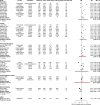Changes in the prevalence of mental health problems during the first year of the pandemic: a systematic review and dose-response meta-analysis
- PMID: 38876492
- PMCID: PMC11177678
- DOI: 10.1136/bmjment-2024-301018
Changes in the prevalence of mental health problems during the first year of the pandemic: a systematic review and dose-response meta-analysis
Abstract
Aim: To describe the pattern of the prevalence of mental health problems during the first year of the COVID-19 pandemic and examine the impact of containment measures on these trends.
Methods: We identified articles published until 30 August 2021 that reported the prevalence of mental health problems in the general population at two or more time points. A crowd of 114 reviewers extracted data on prevalence, study and participant characteristics. We collected information on the number of days since the first SARS-CoV-2 infection in the study country, the stringency of containment measures and the number of cases and deaths. We synthesised changes in prevalence during the pandemic using a random-effects model. We used dose-response meta-analysis to evaluate the trajectory of the changes in mental health problems.
Results: We included 41 studies for 7 mental health conditions. The average odds of symptoms increased during the pandemic (mean OR ranging from 1.23 to 2.08). Heterogeneity was very large and could not be explained by differences in participants or study characteristics. Average odds of psychological distress, depression and anxiety increased during the first 2 months of the pandemic, with increased stringency of the measures, reported infections and deaths. The confidence in the evidence was low to very low.
Conclusions: We observed an initial increase in the average risk of psychological distress, depression-related and anxiety-related problems during the first 2 months of the pandemic. However, large heterogeneity suggests that different populations had different responses to the challenges imposed by the pandemic.
Keywords: COVID-19; Data Interpretation, Statistical; Depression.
© Author(s) (or their employer(s)) 2024. Re-use permitted under CC BY. Published by BMJ.
Conflict of interest statement
Competing interests: AC has received research, educational and consultancy fees from INCiPiT (Italian Network for Paediatric Trials), CARIPLO Foundation, Lundbeck and Angelini Pharma. VP received consulting fees from Google Modern Health. CK is a cofounder of Wida, a digital mental health platform. TAF reports personal fees from Boehringer-Ingelheim, Daiichi Sankyo, DT Axis, Kyoto University Original, Shionogi, SONY and UpToDate, and a grant from DT Axis and Shionogi, outside the submitted work; In addition, TAF has a patent 7448125, and a pending patent 2022-082495, and intellectual properties for Kokoro-app licensed to Mitsubishi-Tanabe. SL received consulting fees from Alkermes, Angelini, Karuna, Kynexis, Lundbeck, Neurotorium, Novo Nordisk, Otsuka, Roche, ROVI, TEVA and honoraria for lectures and presentations from Angelini, Apsen, Eisai, Ekademia, Gedeon Richter, Janssen, Lundbeck, Medichem, Medscape, Merck, Mitshubishi, Recordati, ROVI, Sanofi Aventis. SNV receives royalties from UpToDate Inc for authorship of materials on depression and pregnancy. From The MHCOVID Crowd Investigators: EO has received consulting fees Angelini Pharma. AS received 30 days of complimentary access from Elsevier to Science Direct, Scopus, Reaxys and Geofacets after reviewing a manuscript for CHEST.
Figures



References
-
- Winkler P, Krupchanka D, Roberts T, et al. . A blind spot on the global mental health map: a scoping review of 25 years’ development of mental health care for people with severe mental illnesses in central and Eastern Europe. Lancet Psychiatry 2017;4:634–42. 10.1016/S2215-0366(17)30135-9 - DOI - PubMed
-
- Rourke A. Global report: WHO says COVID-19 ‘may never go away’ and WARNS of mental health crisis. The Guardian; 2020. Available: https://www.theguardian.com/world/2020/may/14/global-report-who-says-cov... [Accessed 15 May 2020].
Publication types
MeSH terms
LinkOut - more resources
Full Text Sources
Medical
Miscellaneous
